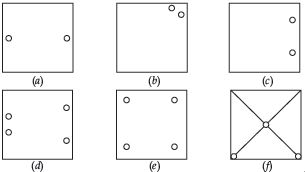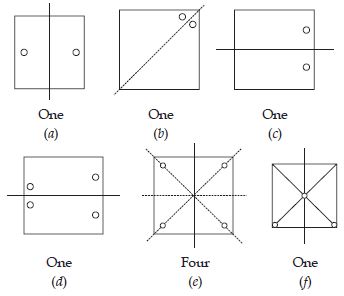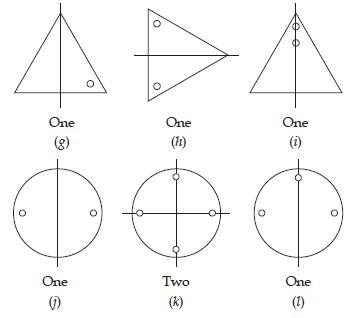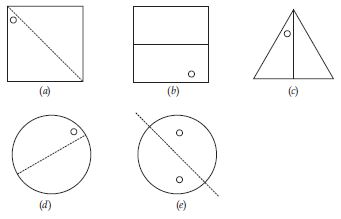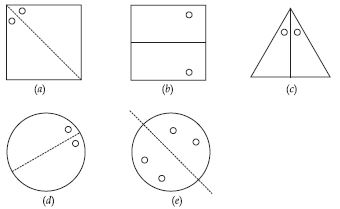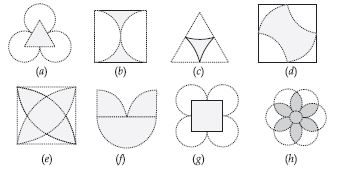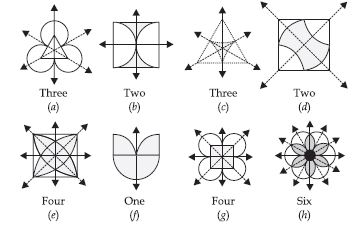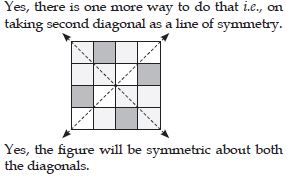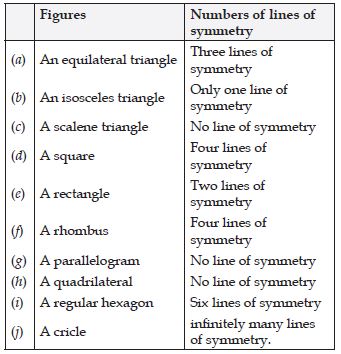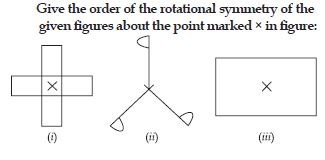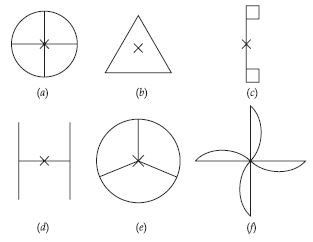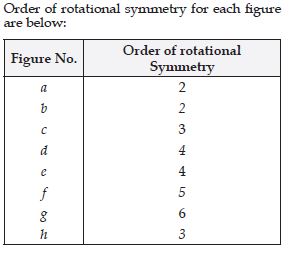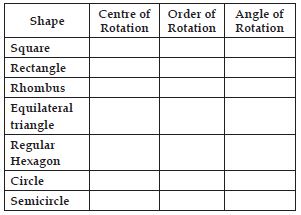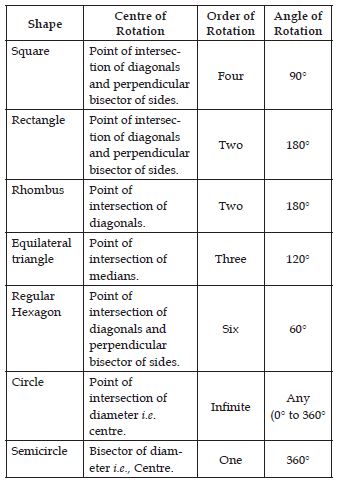Question 1:
Find the axes of symmetry for the followng:
Answer:
Each figure is symmetrical and shown by dotted lines and the number of lines of symmetry are written below each figure.
Question 2:
Given the line(s) of symmetry, find the other hole(s):
Answer:
Each figure is symmetrical and shown by dotted lines and the other holes are shown below in each figure:
Question 3:
In the following figures, the mirror line (i.e., the line of symmetry) is given as a dotted line. Complete each figure performing reflection in the dotted (mirror) line. (You might perhaps place a mirror along the dotted line and look into mirror for the image). Are you able to recall the name of the figure you complete?
Answer:
On completing all of the figures and drawing their lines of symmetry. The name of each figure are written below each figure:
Question 4:
The following figures have more than one line of symmetry. Such figures are said to have multiple lines of symmetry.
Identify multiple lines of symmetry, if any, in each of the following figures:
Answer:
Multiple lines of symmetry of each figure are shown below:
Question 5:
Copy the figure given here.
Take any one diagonal as a line of symmetry and shade a few more squares to make the figure
symmetric about a diagonal. Is there more than one way to do that? Will the figure be
symmetric about both the diagonals?
Answer:
On taking one diagonal as a line of symmetry and some more shaded square are shown below:
Question 6:
State the number of lines of symmetry for the following figures:
(a) An equilateral triangle
(b) An isosceles triangle
(c) A scalene triangle
(d) A square
(e) A rectangle
(f) A rhombus
(g) A parallelogram
(h) A quadrilateral
(i) A regular hexagon
(j) A cricle
Answer:
Question 7:
What letters of the English alphabet have reflectional symmetry (i.e., symmetry related to
minnor reflection) about:
a vertical mirror
Answer:
Letter of the English alphabet having reflectional
symmetry across:
a vertical mirror
A, H, I, M, O, T, U, V, W, X, Y
Question 8:
What letters of the English alphabet have reflectional symmetry (i.e., symmetry related to
minnor reflection) about:
a horizontal mirror
Answer:
Letter of the English alphabet having reflectional
symmetry across:
a horizontal mirror
B, C, D, E, H, I, K, O, X
Question 9:
What letters of the English alphabet have reflectional symmetry (i.e., symmetry related to
minnor reflection) about:
both horizontal and vertical mirrors.
Answer:
Letter of the English alphabet having reflectional
symmetry across:
Both horizontal and vertical mirrors
O, X, I, H
Question 10:
Give three examples of shapes with no line of symmetry.
Answer:
Three examples of shapes with no line of
symmetry are:
(1) A Scalene triangle
(2) A parallelogram
(3) Trapezium
(4) ‘L’ shaped buliding.
Question 11:
What other name can you give to the line of symmetry of:
an isosceles triangle?
Answer:
Other name to the line of symmetry of
an isosceles triangle are median.
Question 12:
What other name can you give to the line of symmetry of:
a circle?
Answer:
Other name to the line of symmetry of
a circle are diameter.
Question 13:
Can you now tell the order of the rotational symmetry for an equilateral triangle?
Answer:
The order of rotational symmetry for an equilateral triangle is 3, since the triangle takes 3 turns to reach its original position.
Question 14:
How many positions are there at which the equilateral triangle looks exactly the same, when rotated about its centre by 120°?
Answer:
The triangle looks the same in all the 3 positions when rotated about its center by 120°.
Question 15:
Which of the following shapes have rotational symmetry about the marked point
Answer:
Shapes having rotational symmetry about the marked point (rotation by 90°) are (i), (ii), (iii) and (iv).
Question 16:
Answer:
Order of rotational symmetry of given figures
are:
(i) Four (ii) Three (iii) Four.
Question 17:
Which of the following figures have rotational symmetry of order more than 1?
Answer:
Figure (a) has rotational symmetry about the
marked point through an angle of 90°.
Figure (b) has rotational symmetry about the
marked point through an angle of 360°.
Figure (c) has no rotational symmetry about the
marked point.
Figure (d) has rotational symmetry about the
marked point through an angle of 180°.
Figure (e) has rotational symmetry about the
marked point through an angle of 120°.
Figure (f) has rotational symmetry about the
marked point through an angle of 90°.
Question 18:
Give the order of rotational symmetry for each figure:
Answer:
Question 19:
Some of the English alphabets have fascinating symmetrical structures. Which capital letters
have just one line of symmetry (For example, E)? Which capital letters have a rotational
symmetry of order 2?
By attempting to think on such lines, you will be able to fill in the following table.
Answer:
Question 20:
Name any two figures that have both line symmetry and rotational symmetry.
Answer:
Two figures that have both line symmetry as
well as rotational symmetry are:
(i) Circle (ii) Equilateral Triangle.
Question 21:
If a figure has two or more lines of symmetry, should it have rotational symmetry of order more than 1?
Answer:
Yes, a figure which has two or more lines of symmetry have a rotational symmetry.
Question 22:
Fill in the blanks:
Answer:
Question 23:
Name the quadrilaterals which have both line and rotational symmetry of order more than 1.
Answer:
Square have both line and rotational symmetry of order more than 1.
Question 24:
After rotating by 60° about a centre, a figure looks excatly the same as its original position. At what other angles will this happen for the figure.
Answer:
After rotating by 60° about a centre, a figure
looks exactly the same as its original position.
This will happen for the figure at angles 120°,
180°, 240°, 300°, 360° respectively.
Question 25:
Can we have a rotational symmetry whose angle of rotation is
45°?
Answer:
Yes
Question 26:
Can we have a rotational symmetry whose angle of rotation is
17°?
Answer:
No

